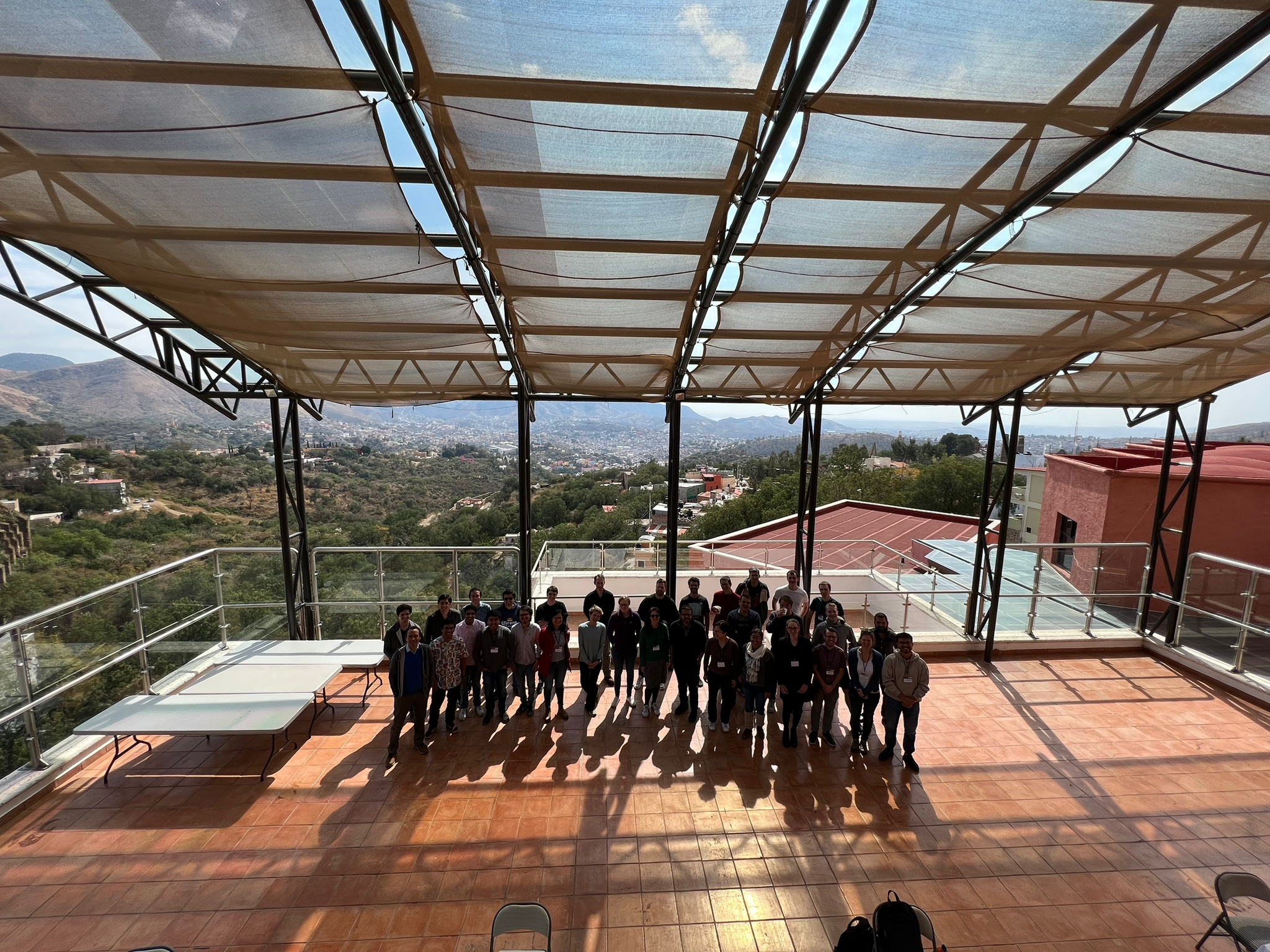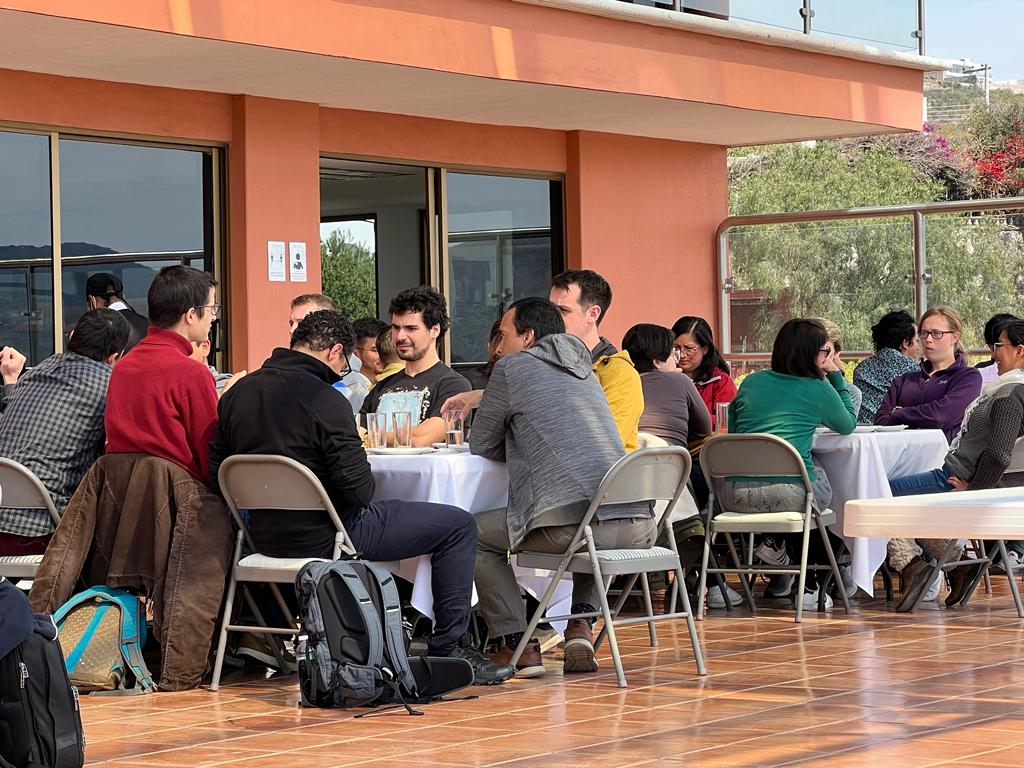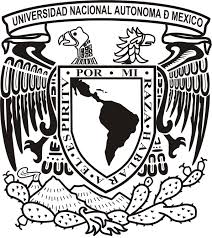BUC Probability meeting
This meeting will take place at CIMAT, in Guanajuato, from the 16th to the 20th of January 2023. The focus will be on common interests between researchers in the BUC communit. The meeting consists of three graduate minicourses, some talks by researchers from Latin America and Europe, as well as shorter talks by students from all participating countries.


Minicourses by:
A) Ellen Powell (Durham)
Introduction to the Gaussian free field (Notes)
B) Hubert Lacoin (IMPA)
Exploring the phase diagram of Complex Gaussian Multiplicative Chaos (Notes)
C) Emmanuel Schertzer (Vienna)
Pulled and pushed waves in population genetics (Slides)
Talks by:
T1) David Croydon (Kyoto) (Slides)
T2) Saraí Hernández-Torres (UNAM)
T3) Marcelo Hilario (Belo Horizonte)
T4) Sandra Palau (UNAM)
Organizers
Daniel Kious
Andreas Kyprianou
Sandra Palau
Juan Carlos Pardo
Thanks to Sonny Medina and Carlo Scali for organising the short sessions





Schedule
| Monday | Tuesday | Wednesday | Thursday | Friday | |
|---|---|---|---|---|---|
| 9-10 | Powell 1 | Schertzer 1 | Schertzer 2 | Powell 4 | Lacoin 4 |
| 10-10.30 | Coffee | Coffee | Coffee | Coffee | Coffee |
| 10.30-11.00 | Gonzalez | Scali | Powell 3 | Medina Mata |
Louvet |
| 11.00-11.30 | Croydon | Hernandez-Torres | Hilário | Palau | |
| 11.30-12.00 | Lacoin 3 | ||||
| 12.00.12.30 |
Contreras |
Da Silva | Talyigas | Johnston | |
| 12.30-2.00 | Lunch | Lunch | Discussions | Lunch | Lunch |
| 2.00-3.00 | Discussions | Discussions | Discussions | Schertzer 4 | |
| 3.00-4.00 | |||||
| 4.00-5.00 | Lacoin 1 | Lacoin 2 | Schertzer 3 | ||
| 5.00-6.00 | Reception | Powell 2 | Reception 2 |
List of participants
|
Wilfred Armfield (Bath, UK) |
Apolline Louvet (Bath, UK) |
Abstracts of the mini-courses
A) "Introduction to the Gaussian free field" by Ellen Powell
Find Ellen's notes here.
One simple way to think of the Gaussian Free Field (GFF) is that it is the most natural and tractable model for a random function defined on either a discrete graph (each vertex of the graph is assigned a random real-valued height, and the distribution favours configurations where neighbouring vertices have similar heights) or on a subdomain of Euclidean space. The goal of these lectures is to give an elementary, self-contained introduction to both of these models, and highlight some of their main properties. We will start with a gentle introduction to the discrete GFF, and discuss its various resampling properties and decompositions. We will then move on to the continuum GFF, which can be obtained as an appropriate limit of the discrete GFF when it is defined on a sequence of increasingly fine graphs. We will explain what sort of random object (i.e, generalised function) it actually is, and how to make sense of various properties that generalise those of the discrete GFF.
B) "Exploring the phase diagram of Complex Gaussian Multiplicative Chaos" by Hubert Lacoin
Find Hubert's notes here.
Gaussian Multiplicative Chaos (or GMC) is defined as the random distribution on $\mathbb{R}^d$ which is obtained by taking the exponential of a $\log$-correlated field. It has been introduced by Kahane in the 85, in an effort to given a mathematical meaning to an informal model for dissipation of energy in turbulent fluids introduced a decade earlier by Mandelbrot. In the last two decades, the object has gathered the interest of a large community due to its connection with two dimensional Quantum field theories including Liouville Quantum gravity.
Kahane's work was focused on studying $e^{\gamma X(x)}\mathrm{d}x$ where $X$ is a real valued $\log$ correlated field and $\gamma$ is a real parameter, but more recently, research efforts have been made to extend to construction to the remainder of the complex plane $\gamma\in \mathbb C \setminus \mathbb R$. The aim of this lecture is to introduce the audience to this field of research.
C) "Pulled and pushed waves in population genetics" by Emmanuel Schertzer
Find Emmanuel's slides here.
The course will be divided into two parts:
Part I. The celebrated Brunet and Derrida model (97) is a discrete time dynamics. The system consists of N individuals characterised by an abstract fitness value on the real line. At every generation, individuals produce a large number of particles and the N-rightmost children are selected at the next generation. The resulting fitness wave is known to be “pulled” in the sense that the most recent common ancestor (MRCA) of the population is likely to be located at the edge of the front propagation. Further, the rescaled genealogy of the population converges to the Bolthausen-Sznitman coalescent. In the part of this course, I will introduce a noisy version of the Brunet and Derrida model where children are randomly sampled according to their fitness (Mallein Cortines 19). We will show the existence of a critical noise parameter separating a semi vs fully pulled regime. More precisely, I will show the existence of a phase transition from a Bolthausen-Sznitman coalescent to a Poisson-Dirichlet coalescent.
Part II. The second part of this course is motivated by recent results on the noisy F-FPP equation with Allee effect. ut = 1 2 uxx + u(1 − u)(1 + Au) + p u(1 − u)η where η is a space-time white noise. Numerical results and heuristics suggest the existence of an interesting phase transition between a pulled, semi pushed and fully pushed regimes. In order to explain those different phases, I will introduce a class of branching Brownian motions with inhomogeneous branching rates. This class of model was recently introduced in Tourniaire (22) and can be described as a perturbation of the celebrated model of Berestycki, Berestycki, Schweinsberg (13). I will show the existence of a phase transition mirroring the one observed in the noisy F-KPP equation. The proof will be based on a general approach that consists in computing the “moments” of a branching process from spinal decompositions (Foutel–Rodier, Schertzer 22).
Titles and abstracts of the invited talks:
T1) "Scaling limits of random walks on random graphs: An electrical resistance approach" by David Croydon
In describing properties of disordered media, physicists have long been interested in the behaviour of random walks on random graphs that arise in statistical mechanics, such as percolation clusters and various models of random trees. Random walks on random graphs are also of interest to computer scientists in studies of complex networks. In 'critical' regimes, many of the canonical models exhibit large-scale fractal properties, which means it is often a challenge to describe their geometry, let alone the associated random walks. In this talk, I will describe an approach suitable for understanding various 'low-dimensional' models of random walks on random graphs that builds on the deep connections that exist between electrical networks and stochastic processes. The talk will include plenty of examples.
T2) "The time constant of finitary random interlacements" by Saraí Hernández-Torres
Finitary random interlacements (FRI) is a Poisson point process of geometrically killed random walks on Z^d, with d ≥ 3. A parameter u > 0 modulates the intensity of the point process, while T > 0 is the expected path length. FRI exhibits a phase transition, but challenges arise from its lack of global monotonicity on the parameter T.
In the supercritical regime, FRI (u, T) has a unique infinite cluster on which we consider its chemical distance. This talk focuses on the associated time constant. We will review the results and recent advances. The latter reports ongoing work with Zhenhao Cai, Eviatar Procaccia, Ron Rosenthal and Yuan Zhang.
T3) "Percolation on randomly stretched lattice" by Marcelo Hilario
We revisit a model of percolation on a random lattice first studied by Hoffman [CMP 254, 1-22, 2005]. Starting from the usual square lattice, rows and columns are selected uniformly at random, and all the edges lying along a selected row or column are removed at once. This gives rise to a randomly stretched version of the square lattice. Given a realization, independent bond percolation is performed on top of it. The goal of the present talk is to present a proof for the phase transition for this model. Our proof shares some similarities with the original proof by Hoffman and with the ideas in Kesten et. al. [EJP 27, 1-49 2022] but also brings some new ideas that we expect to be useful in new situations. Based on a joint ongoing work with Marcos Sá, Augusto Teixeira, and Remy Sanchis.
T4) "Coalescent Structure of Galton Watson trees in varying environment" by Sandra Palau
--Marco Antonio López Ortiz: "Targeted cutting of random recursive trees"
We propose a method of cutting down a random recursive tree that focuses on its higher degree vertices. Enumerate the vertices of a random recursive tree of size $n$ according to a decreasing order of their degrees. The targeted vertex-cutting process is performed by sequentially removing the vertices in the listed order and keeping only the subtree containing the root. The algorithm ends when the root is removed. The total number of steps for this procedure,$K_n$ , is upper bounded by $Z_{≥D}$, which denotes the number of vertices that have degree at least as large as the degree of the root. We obtain that the first order growth of $K_n$ is upper bounded by $n {1−ln 2}$, which is substantially smaller than the required number of removals if, instead, the vertices were selected uniformly at random. More precisely, we prove that $ln(Z_{≥D})$ grows as $ln(n)$ asymptotically and obtain its limiting behavior in probability. Moreover, we obtain that the k-th moment of $ln(Z_{≥D})$ is proportional to $(ln(n))^k$.
-_-_-_-_-_-_-_-
--Isaac González: "Asymptotic moments of spatial branching processes"
Consider either a branching Markov process or a superprocess on a general space, with non-local branching mechanism. For a general setting in which the first moment semigroup displays a Perron-Frobenius type behaviour and with an appropriate deterministic normalisation, we find the limit behaviour of the k-th order moment of the process in terms of the principal right eigenfunction and left eigenmeasure, which can be identified explicitly as either polynomial in t or exponential in t, depending on whether the process is critical, supercritical or subcritical. The method we employ is extremely robust and we are able to extract similarly precise results that additionally give us the moment growth with time of the integrated moments, which we can think of as characterising the running occupation measure of the process.
-_-_-_-_-_-_-_-
--Carlo Scali: "Quenched invariance principle for biased random walks in random conductances in the sub-ballistic regime"
We consider a biased random walk in positive random conductances on $\mathbb{Z}^d$ for $d\geq 5$. In the sub-ballistic regime, Fribergh and Kious proved the convergence, under the annealed law, of the properly rescaled random walk towards a Fractional Kinetics. I will explain that a quenched equivalent of this theorem is true and a strategy to simplify the question. This is joint work with A. Fribergh and T. Lions.
-_-_-_-_-_-_-_-
--Jesus Contreras: "Contributions on local times of Spectrally Negative Lévy Processes"
This talk includes two topics. The first one is about scale functions, which are well known and appear in the expression of the Laplace transform of the first exit time T of an interval. It turns out we can consider the exit problem for more general functionals related to T, the process and its supremum. We achieve this by using excursion theory, and the corresponding generalized scale functions are closely related to the process of local times via the occupation density formula. For the second part, I will briefly mention some advances we have made on trying to establish analogues of the First and Second Ray-Knight theorems for SNLPs. Both of these are joint works with Victor Rivero.
-_-_-_-_-_-_-_-
--William Da Silva: "Growth-fragmentation processes with types"
We introduce a new family of processes with types, which are a natural extension of Bertoin's growth-fragmentation processes. We show how the theory of Markov additive processes can be leveraged to describe these processes, and study their properties. This is joint work with Juan Carlos Pardo (CIMAT).
-_-_-_-_-_-_-_-
--Sonny Medina: "Directional excursions of the isotropic α-stable Lévy and a new example of Deep Wiener-Höpf factorisation"
In this talk we will show some fluctuation identities for the isotropic α-stable Lévy process in regard to half-spaces and their normal vectors. These complement the recent results of Kyprianou, Rivero and Satitkanitkul, in which a theory of radial excursions of this process is developed by appealing to its Lamperti-Kiu decomposition. We will finalise by illustrating the so-called Deep Wiener-Höpf factorisation of a related Markov Additive Process, in terms of the ascending and descending ladder potentials.
-_-_-_-_-_-_-_-
--Dante Mata: "On the bailout dividend problem with periodic dividend payments and termination at an exponential time"
We study a version of the bailout optimal dividend problem driven by a spectrally negative Lévy process under the constraint that dividend payments can be made only at the arrival times of an independent Poisson process while capital can be injected continuously in time, and with termination at an independent exponential time. We show the optimality of the Parisian-classical reflection strategy.
-_-_-_-_-_-_-_-
--Zsofia Talyigas: "Genealogy and speed results on the N-particle branching random walk"
The $N$-particle branching random walk is a discrete time branching particle system with selection. We have $N$ particles located on the real line at all times. At every time step each particle is replaced by two offspring, and each offspring particle makes a jump of non-negative size from its parent's location, independently from the other jumps, according to a given jump distribution. Then only the $N$ rightmost particles survive; the other particles are removed from the system to keep the population size constant. In this talk I will first discuss the (very different) long-term behaviours of the speed of the particle cloud in cases of different jump distributions. Then, I will explain our main result, which concerns the genealogy of the population in the case when the jump distribution has polynomial tails and the population is large.
The result says that at a typical large time the genealogy of the population is given by a star-shaped coalescent.
This is joint work with Sarah Penington and Matthew Roberts.
-_-_-_-_-_-_-_-
--Apolline Louvet: "A toy model for studying the consequences of the microscopic reproduction dynamics at the edge of an expanding population"
Studying the growth dynamics of stochastic growth models is a question of interest in population dynamics and percolation theory. Showing whether the growth is linear in time is generally already a challenging question, and there are few stochastic growth models for which the actual speed of growth is known. In this talk, I will show that the macroscopic expansion dynamics is heavily influenced by the microscopic reproduction dynamics at the front edge, which makes it challending to study the growth dynamics precisely. In order to do so, I will first use the example of a stochastic growth model for populations expanding in a continuum to show why the distinctive reproduction dynamics at the front edge makes intuition fail when trying to obtain the actual speed of growth. I will then introduce the 2-Columns Growth Process, which is a toy model for studying the effect of the reproduction dynamics at the front edge on the speed of growth. I will show how it is possible to obtain an explicit speed of growth for the process.
Based on a joint work with Amandine Véber (MAP5, Univ. Paris Cité).
-_-_-_-_-_-_-_-
--Sam Jonhston: "Probability on trees and the Jacobian conjecture"
The Jacobian conjecture states that whenever $F:\mathbb{C}^n \to \mathbb{C}^n$ is a polynomial map (i.e. it has polynomial components), and the determinant of its Jacobian matrix is constant, then F is bijective and its inverse is a polynomial map.
It turns out that if $F:\mathbb{C}^n \to \mathbb{C}^n$ is any smooth function that is bijective in some neighbourhood, then the local inverse of F may be described in terms of multitype Galton-Watson trees with complex branching probabilities.
In this talk, we use the description of the inverse of a polynomial map in terms of multitype trees to study the Jacobian conjecture from a new combinatorial perspective.
Joint work with Elia Bisi, Piotr Dyszewski, Nina Gantert, Joscha Prochno, and Dominik Schmid.
